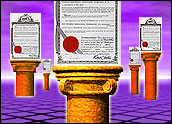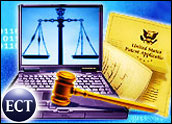
For better or worse, 2006 is going to be remembered as the year the U.S. court system should have set up a special turnstile for patent cases; litigation in this usually less-than-sexy body of law seemed to continually challenge once-established points of law.
The result? Major case law was established — not once, but several times — that has caused both patent attorneys and intellectual property owners to rethink strategies on a fundamental level.
Counted among these cases was last week’s Supreme Court decision inMedImmune v. Genentech, which reversed the U.S. Court of Appeals for the Federal Circuit. Essentially, the case has paved the way for licensee holders to challenge a patent without actually breaching the license. Many attorneys expect that the decision will increase traffic in the courts.
A Look Back
Many other decisions made last year have had the opposite effect.Part 1 of this series looks ateBay v. MercExchange, for instance, in which the Supreme Court held that permanent injunctions should not automatically be awarded in patent cases.
Part 2 of this series examines Metabolite v. LabCorp and NTP v. Research In Motion.
The case poised to have the biggest impact of all —KSR v. Teleflex — is going to be decided this year.
Next to the far-reaching potential of those decisions, other cases look downright insignificant. However, patent attorneys that spoke to the E-Commerce Times were at no loss to provide examples of important cases decided last year that might not have gotten the attention of eBay v. MercExchange or KSR v. Teleflex, but were nonetheless significant.
DSU v. JMS
Decided at the end of the year, DSU Medical v. JMS will likely prove to be one of the most influential patent cases of 2006, Ilan Barzilay, an attorney with Wolf, Greenfield & Sacks, told the E-Commerce Times.
“In DSU, the United States Court of Appeals for the Federal Circuit finally resolved the open question of how much intent is necessary for a finding of liability for inducement to infringe,” he stated, adding, “The Federal Circuit held that to be liable for inducement — a common charge leveled by patent holders, particularly in cases involving software and method patents, such as the famous BlackBerry case — a defendant must intend to cause infringement of the patent, rather than simply intend to cause the acts which happen to infringe.”
This stringent standard will make it more difficult for holders of method and software patents to go after distributors of infringing software, Barzilay said, or pursue those who may be operating infringing software over the Internet.
Attaining Clarification
DSU v JMS is a notable case, agreed John Moran, an intellectual property attorney at Holland & Knight.
“It is important, because it clarifies and narrows the application of inducement to infringe,” he told the E-Commerce Times.
The court expressly discussed good faith reliance on opinion of counsel advising either noninfringement or invalidity as evidence of lack of specific intent to induce acts of infringement, Moran noted.
“Thus, no longer will an alleged infringer’s product and instructions on how to use the product be sufficient for inducement to infringe,” he stated.
Going After Microsoft
Barzilay also nominated Technologies v. Microsoft as a consequential case in 2006.”This was the first case in the notoriously patent-friendly Eastern District of Texas to be affected by the Supreme Court’s decision in the eBay case — and affected it was,” he stated.
Despite a jury verdict of US$133 million in favor of the plaintiff, Barzilay said, the court refused to enter an injunction halting the sales of Microsoft Windows and Office products. It applied the eBay ruling and found that the plaintiff did not meet the traditional test for entry of a permanent injunction.
Several other cases similar to this one have since followed, he commented, both in the Eastern District of Texas, and in jurisdictions across the country.
Visto Gets a Verdict
Finally, Rob Becker, an intellectual property partner for Manatt Phelps & Phillips and chair of the firm’s patent litigation and prosecution groups, singled out Visto v. Microsoft — a patent infringement action that is pending against Microsoft in the Eastern District of Texas — as an important recent case.
Visto holds a portfolio of wireless messaging and e-mail, calendar and contact synchronization patents, including patents that are alleged to support Microsoft’s Messaging and Security Feature Pack for Windows Mobile 5.0 and Service Pack 2 for Microsoft Exchange Server 2003.
Visto also has similar suits pending against Research In Motion andGood Technology in the Eastern District of Texas involving the Visto patent portfolio, Becker informed the E-Commerce Times.
“Earlier this year, Visto prevailed in another suit on the Visto patents — Visto v. Seven Networks,” he noted. “Seven provides the Sprint PCS Business Connection software and similar software to Cingular. In late April, a jury found that Seven willfully infringed the Visto portfolio.”
In December, Becker reported, Visto received a final judgment, which includes a double damage award, costs, attorneys fees and a stayed injunction.














































Social Media
See all Social Media